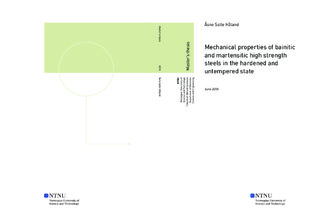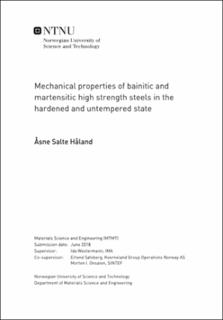| dc.description.abstract | The objective of the research project named RoHard, is to increase the understanding of the interaction between the quality of the incoming materials, the hardening process and the resulting mechanical properties of the products [1]. In relation to that work, it was interesting to investigate the mechanical properties of bainitic and martensitic high strength steel with varying alloy content, in the hardened and untempered state. The steel alloys 42M13B, 50CrMo4, 100Cr6, 100CrSiMn6-5-4, 11M13CB, 18MnCrSiMoVB6, 27MnSiCrVB6 and 35MnCrMoVB5 were looked at.
This work has looked at the possibility to use steel austempered to a lower bainitic microstucture for purposes where martensite are used today. According to the literature, austemperd steels should have benefits like less internal stresses, superior toughness and ductility at equivalent hardness, less distortion and no need for subsequent tempering [2, p.485].
Three main hardening procedures have been performed. These are direct hardening, martempering and austempering. Before hardening, samples were austenitized at a higher temperature of 1200 oC followed by one lower temperature between 840-900 oC, or only at one lower temperature. Direct hardening was performed by quenching the samples in a salt bath at 180 oC directly from the austenitizing temperature. Martempering and austempering were performed by holding the samples a given time in the quenching bath, at a temperature 25 oC below Ms and just above Ms after austenitizing.
The hardening procedures were adjusted to the alloys based on alloy content, feedback from the steel producer Ascometal and the RoHard companies, in addition to performed experiments. This was done to be able to investigate mechanical properties of bainite vs. martensite at similar hardnesses. Steels with hardnesses around 700 and 400 HV were tested. The effect of prior austenite grain size on mechanical properties of bainite vs. martensite, in addition to the tendency of mechanical properties for different hardness categories and the effect of silicon on austempered steel was also investigated. The mechanical properties of the steels were found by use of hardness testing, notch-impact testing and tensile testing. In addition, examination of microstructure, prior austenite grain size determination and studying of fracture surfaces have been performed.
For a hardness of about 700 HV, read total energy from charpy testing was higher for direct hardened 42M13B than for austempered 100Cr6 and 100CrSiMn6-5-4. Stress at offset yield was higher for austempered 100Cr6 and 100CrSiMn6-5-4 than for direct hardened 42M13B and 50CrMo4. For a hardness of about 400 HV, austempered 18MnCrSiMoVB6, 27MnSiCrVB6 and 35MnCrMoVB5 showed a considerable lower read total energy from charpy testing than direct hardened 11M13CB, but the total area under the stress-strain curves were higher. Peak stress was higher for austempered 27MnSiCrVB6 and 35MnCrMoVB5 than for the direct hardened samples. And the austempered 18MnCrSiVB6 showed a slightly lower value of peak stress compared to direct hardened 11M13CB. All these samples were austenitized at only one lower temperature between 840-900 oC.
For austempered 100Cr6 and 100CrSiMn6-5-4 austenitized at 1200 oC followed by a lower austenitizing temperature between 840-900 oC and austenitized only at one lower temperature, the read total energy from charpy testing and stress-strain properties were decreasing with increasing prior austenite grain size. Direct hardened and martempered 42M13B and 50CrMo4 austenitized at 1200 oC followed by a lower austenitizing at 870 oC and austenitized only at one lower temperature, showed higher read total energy values for the fine grained samples of 42M13B compared to the coarser grained samples of this alloy. For 50CrMo4 the energy values were quite equal for all grain sizes. Stress at offset yield was increasing with decreasing grain size. All these samples had a hardness around 700 HV.
Direct hardening, martempering and austempering of 18MnCrSiMoVB6, 27MnSiCrVB6 and 35MnCrMoVB5, showed a trend where the values for hardness, stress at offset yield and peak stress were highest for the direct hardened samples, lower for the martempered samples and lowest for the austempered samples. Read total energy values from charpy testing of 18MnCrSiMoVB6 and 27MnSiCrVB6 were highest for the martempered samples, lower for the direct hardened samples and lowest for the austempered samples. The values for read total energy of 35MnCrMoVB5, were quite equal for all heat treatments. The ductility was highest for the austempered samples, lower for the martempered samples and lowest for the direct hardened samples.
Austempered 100CrSiMn6-5-4 showed poorer mechanical properties compared to austempered 100Cr6. A considerable difference between these alloys was the higher content of silicon in 100CrSiMn6-5-4. | en |


